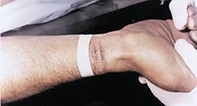Peer Reviewed
Feature Article Occupational health
In pursuit of justice: blunt and sharp injuries
Abstract
Doctors attending patients who have sustained physical injury from an assault will often have to give evidence in court. They must, therefore, understand the basic forensic principles relating to wounds.
Key Points
- Many GPs will be involved in both the care of patients who have been assaulted and in the legal interpretation of injuries resulting from these episodes.
- GPs should have an understanding of the basic forensic principles relating to wounds.
- An accurate description of the injury and classification of its type can provide valuable clues to the type of weapon used, the force used and the spatial relationship of the assailant and victim.
- Injuries with a pattern or those that are contaminated with trace evidence are particularly useful forensically.
- The main types of mechanical injuries include blunt force injuries (bruises, abrasions and lacerations) and sharp force injuries (incisions and penetrating wounds).
Purchase the PDF version of this article
Already a subscriber? Login here.

